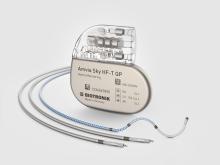Engineering is at our core. We are dedicated innovators who develop cardiovascular, endovascular and neuromodulation solutions one can rely on.
Our broad range of products work to restore blood flow to vessels of the heart (coronary) and body (peripheral) that are narrowed or blocked. We produce a full range of stent systems, balloon catheters and guide wires for patients with coronary and peripheral artery disease.BIOTRONIK is a true innovator in the field, having introduced Pulsar, the world's first 4 F-compatible stent for treating long lesions, in 2009 and Orsiro, the industry's first hybrid drug-eluting stent, in 2011. Over the years our wide range of vascular intervention innovations include Orsiro DES, Resorbable Magnesium Scaffold, Drug Coated Balloon Catheters, Multifunctional Catheters and many more. Patient well being is our top priority and has been for 60 years.
BIOTRONIK is pleased to announce the availability of an expanded Maximum Allowed Diameters (MAD) range for the Orsiro® Mission Drug Eluting Stent (DES). Diameters 2.25mm to 3.00mm of the Orsiro Mission DES can now be extended up to 4.0mm, while diameters 3.5mm and 4.0mm can reach up to 5.0mm.This new MAD expansion follows the approvals from CE, FDA, and Health Canada obtained in the past months. This update reflects a global effort for the Orsiro Mission stent technology to match contemporary Percutaneous Coronary Intervention (PCI), enabling practitioners to optimize vessel apposition and conform to tapered anatomies.Subsequently to these approvals, an updated labelling, additionally to the modified Instructions for Use (IFU), will provide further guidance to practitioners.Always consult the Instructions for Use specific to your country when applying the Maximum Allowed Diameters (MAD).More information on Orsiro® Mission DES here.-END-Disclaimer: Orsiro and Orsiro Mission are trademarks or registered
New two-year follow-up data from the BIOMAG-I first-in-human trial confirms a reliable and predictable long-term safety profile for Freesolve™, the third-generation resorbable magnesium scaffold (RMS), establishing it as a true alternative to contemporary drug-eluting stents (DES). The results were presented by Prof. Dr. Michael Haude at the EuroPCR 2024 conference yesterday in Paris. At the 24-month follow-up, the incidence of target lesion failure (TLF) was 3.5% alongside a corresponding 3.5% incidence of target lesion revascularization (TLR) compares favorably with various second-generation DES. No cases of myocardial infarction (MI), cardiac death, or definite/probable scaffold thrombosis were reported.1 “At this two-year time point, the Freesolve RMS with its new Magnesium alloy which allows for increased radial strength, showed again excellent clinical and safety,” said Prof. Michael Haude, Rheinland Klinikum, Neuss, Germany. “With this highly competitive device, we're advancin
BIOTRONIK announced the presentation of the 12-month results from the BIONETIC-I study this week at LINC 2024.The prospective, international, multicenter single-arm observational study evaluated the treatment of de novo, restenotic or occluded iliac lesions in 160 patients with Rutherford Class 2-6 peripheral artery disease using the Dynetic®-35 cobalt chromium balloon-expandable stent system. At baseline, 12.5% of enrolled patients had critical limb ischemia, 90% had calcified lesions (30.7% severe calcification), and there was an average of 85.5% stenosis in the target lesion.The primary endpoint, major adverse events (MAE) at 12 months, was met with a 3.5% rate of MAE1, significantly non-inferior to the historical control threshold (14%). MAE included device- or procedure-related death within 30 days post-index procedure, clinically driven target lesion revascularization (cd-TLR) and major index limb amputation up to 12 months post-index procedure.At 12 months, freedom from cd-TLR was 98.0%, primary paten
BIOTRONIK, a global leader in cardiovascular, endovascular, and neuromodulation solutions, is pleased to announce today the approval of two new indications for the Orsiro® Mission Drug-Eluting Stent (DES): One-month Dual Antiplatelet Therapy (DAPT) for High Bleeding Risk (HBR) Patients: Allows practitioners to offer personalized, shorter DAPT durations to their patients at high risk of bleeding events, in accordance with the most recent guidelines. Calcified Lesions Treatment: Allows practitioners to target more complex lesions with moderate or severe calcification. These new indications complement the recent global regulatory approval of the Orsiro® Mission DES for an increased maximum allowed diameter (MAD) post-dilation (Ø2.25-3.0 mm, MAD: 4.0 mm, Ø3.5-4.0 mm, MAD: 5.0 mm). Following these approvals, labelling including adapted Instructions for Use will become effective in the coming months, pending further national regulatory approvals. Please refer to the Instruc
BIOTRONIK has been granted Breakthrough Device Designation (BDD) from the US Food and Drug Administration (FDA) for the Freesolve™ below-the-knee resorbable magnesium scaffold (BTK RMS). The Freesolve BTK RMS is designed for individuals suffering from chronic limb-threatening ischemia (CLTI). CLTI is the most severe form of peripheral arterial disease (PAD), estimated to affect 11% of the 200 million people suffering from PAD globally. CLTI is associated with high rates of amputation and mortality as well as high care costs.1 To qualify for a Breakthrough Device Designation, a device technology must address an unmet need and show that it has the potential to provide for more effective treatment of life-threatening diseases or irreversibly debilitating conditions. The goal of the program is to provide patients and clinicians with timely access to these breakthrough treatments by accelerating their development, assessment and review while maintaining regulatory standards for pre-market approval
BIOTRONIK is proud to introduce the Micro Rx™ catheter, a novel rapid exchange microcatheter developed to easily enhance guidewire support during percutaneous coronary interventions (PCI). This cutting-edge device, exclusively distributed by BIOTRONIK, is manufactured by IMDS (Interventional Medical Device Solutions). Micro Rx catheter marks the fourth IMDS product BIOTRONIK has brought to the U.S., creating a compelling portfolio of devices which includes NHancer Rx, TrapIT, and ReCross catheters. The Micro Rx catheter features a reinforced distal shaft with a core wire between two layers of braids for optimal push transfer and a tapered tip with the market's smallest tip leading edge1 for high penetration force. Additionally, it features a thoughtfully engineered Proximal-End-Stop that allows for seamless integration of a guide extension catheter2 to gain additional support. The Micro Rx catheter is commercially available today in
